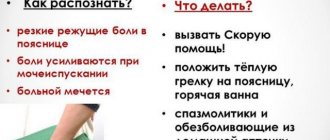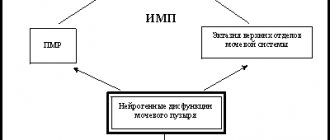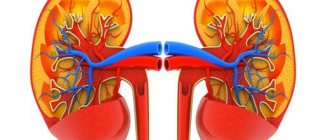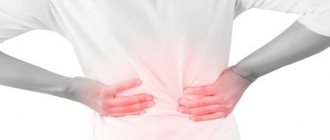Necessity of diet
Renal colic occurs more often in men than in women. The pain and spasm during an attack are severe. These symptoms are caused by the movement of stones through the urinary tract. Pain syndrome can only be relieved with medications, but a diet will help alleviate the patient’s general condition and prevent the development of complications.
Dietary nutrition enhances the effectiveness of drug therapy, prevents the appearance of stones and promotes the dissolution of existing ones. It helps to achieve stable remission.
Patients with renal colic are prescribed diet No. 10. After recovery, in the absence of contraindications, you can return to your normal diet.
Causes of renal colic
Typically, the pain syndrome is caused by the presence of a calculus in the kidneys or ureters - a small stone, in 80% of cases formed from calcium oxalate.
Blood clots, ureteral stricture, and dead tissue can also block the urethra. Among urological pathologies, renal colic in women is sometimes caused by the following diseases:
- pyelonephritis (accumulation of pus and mucus in the lumen of the renal pelvis and ureter);
- hydronephrosis;
- cystitis;
- kidney infarction;
- oncology.
Inflammatory diseases of the female reproductive system that can provoke an attack of renal colic include:
- inflammation of the uterus, appendages;
- ovarian apoplexy;
- ectopic pregnancy;
- pregnancy without visible pathology;
- spontaneous abortion;
- uterine fibroids;
- damage to the fallopian tube.
General rules
Table No. 10 involves reducing the daily caloric content of food consumed, but nevertheless, the diet provides the patient with the necessary amount of nutrients and energy reserves. You shouldn’t consume a lot of proteins and fats, but you shouldn’t exclude them from your diet either.
The basis of the diet should be complex carbohydrates, healthy plant foods. Preference should be given to vegetables and fruits that have a diuretic effect, for example, watermelon.
Salt is excluded from the diet. It can be replaced with vegetable, fruit or sour cream sauces. To make food tastier, you should add lemon juice or herbs to your food.
Features of nutrition for renal colic:
- eat small portions 4-6 times a day;
- follow the regime, the break between meals is no more than 4 hours;
- do not eat less than 3 hours before bedtime;
- cook, steam or stew food.
The drinking regime must be expanded. How much fluid to drink? At least 2-3 liters per day.
Expansion of the drinking regime is possible only in case of urolithiasis. If renal colic occurs against the background of another disease, you need to limit fluid intake to 1 liter per day.
Diagnosis of renal colic
At the time of an attack, it is necessary that the doctor can correctly check the clinical symptoms, carefully collect anamnesis and differentiate the pathology in the woman.
A doctor has the right to diagnose renal colic only after ordering additional examinations. From laboratory methods, as usual, blood is taken for a general analysis, as well as the patient’s urine. Red blood cells, protein, leukocytosis and epithelial cells are found in the urine. The most informative instrumental research methods are ultrasound of the abdominal cavity and pelvic organs, CT or MRI of the kidneys and urinary tract. Ultrasound is performed on a full bladder. If it is impossible to perform a CT scan on the patient, excretory urography is used. According to the textbook “Medical Radiology” authored by Lindenbraten L.D., excretory urography is one of the X-ray methods for examining the urinary tract with contrast and is considered the most reliable in medical practice.
When making a diagnosis, the doctor must differentiate renal colic from other urgent conditions with a similar clinical picture. Such diseases are: acute appendicitis, acute cholecystitis, exacerbation of chronic pancreatitis, perforated gastric ulcer, aortic aneurysm.
Authorized Products
What can you eat? The list of allowed products looks like this:
- cereals;
- pasta;
- vegetables and fruits, especially cucumbers, zucchini, melons, watermelons, apples, beets, cabbage, potatoes and carrots;
- lean meats and fish;
- seafood;
- eggs (eat no more than 2-3 pieces per day);
- butter (in small quantities) and vegetable oils (olive, sunflower, flaxseed);
- low-fat dairy products, unsalted cheeses.
You can eat soups with a second broth, dairy first courses.
As for the liquid consumed, the patient can drink boiled or purified water, juices, compotes, fruit drinks (cranberry and lingonberry are especially useful), jelly, herbal teas, weak black or green tea, rosehip decoction. The use of mineral water should be agreed with your doctor.
Prohibited and Restricted Products
Patients with renal colic should not eat the following foods:
- lard, fatty meats, fish, offal, sausages, smoked meats;
- pickles, marinades, canned food, pates;
- hot spices, mustard, ketchup;
- mushrooms, legumes, spinach, sorrel, radishes, onions and garlic;
- rich broths;
- fresh bread and baked goods;
- high fat dairy products;
- strong coffee, tea and cocoa;
- carbonated drinks;
- chocolate, confectionery products with fatty creams;
- alcohol.
You need to eat only natural food. Eliminate foods with dyes, preservatives and other harmful food additives from your diet.
Renal colic during pregnancy
During pregnancy, a woman is responsible not only for herself, but also for the child.
Therefore, during this period she should monitor her health very carefully. During pregnancy, immunity decreases and a woman is more susceptible to urolithiasis, especially if she has chronic kidney disease. An attack of renal colic during pregnancy is dangerous because it can provoke an increase in the tone of the uterus and cause premature birth. If an attack occurs, you must urgently call an ambulance. Self-relief of an attack, the use of heating pads and hot baths in this situation are strictly contraindicated. Treatment with folk remedies only with the permission of a doctor.
The main task is extremely rapid relief of pain and elimination of spasm of the urinary tract. Only those drugs that do not have a negative effect on the fetus are taken into account when prescribing. Antispasmodics include No-Shpu and Nitroglycerin. Sometimes the drugs of choice are selective antispasmodics, the point of application of which is the smooth muscles of the ureters (Cystenal, Avisan). Herbal preparations with diuretic and anti-inflammatory properties are also prescribed: Canephron, Phytolysin, Urolesan.
Treatment of pregnant patients with renal colic is carried out only in a hospital setting to reduce the risk of possible complications.
Dietary recommendations for different types of stones
The diet is selected by the doctor individually for each patient, taking into account the composition of the stones, as well as the characteristics of the course of urolithiasis and the presence of concomitant kidney diseases.
Oxalate
This is the most common type of stone. To prevent their formation, you need to reduce the amount of protein (up to 100 g per day) and foods high in vitamin C. Limit intake of rosehip decoction, consumption of apples, grapes, strawberries and other fruits containing ascorbic acid.
To remove oxalates, you can eat cucumbers, watermelons and melons. Vitamin complexes containing magnesium, retinol and B vitamins are useful.
Phosphate
For phosphate stones, foods high in vitamin C, on the contrary, are beneficial. The basis of the diet should be lean meats and poultry, vegetable oil, cereals, fruits and sour vegetables. Rosehip decoction, honey, pumpkin, watermelon are useful.
It is worth excluding milk, cottage cheese, fish, nuts and potatoes from the menu.
Urate
It is necessary to limit protein intake to 100 g per day. Vegetables, sweet fruits, low-fat fish, meat and poultry, porridge (except buckwheat), dairy and fermented milk products are allowed.
You can't eat cheese or sour berries.
Treatment of renal colic
Emergency care is allowed only if an attack of renal colic bothers the patient not for the first time or the diagnosis is not in doubt.
It is very important to reassure the woman, as stress increases pain. To relieve spasm, the patient must take a drug from the group of antispasmodics (No-Shpa, Drotaverine, Papaverine). If you don’t have these medications in your home medicine cabinet, you can use Baralgin (an analgesic with an antispasmodic effect). Before the ambulance arrives, you should take 1-2 tablets. If possible, it is better to administer the drugs parenterally (intramuscularly). When none of the above is at hand, you can take a Nitroglycerin tablet under the tongue until it is completely absorbed. All medications taken by the woman before the arrival of specialists must be recorded for presentation to the paramedic or emergency doctor.
The use of a heating pad and a warm bath is currently controversial. If you are not sure that the pain syndrome is associated with an attack of renal colic, then you should refrain from these procedures, otherwise you can only do harm.
Upon arrival of the emergency medical team, the woman’s condition is assessed and, if necessary, treatment is started. The main three areas of drug therapy:
- Administration of analgesics, sometimes narcotics (Promedol, Tramadol).
- Antispasmodics (No-Shpa, Papaverine, Platiphylline) and antiemetics (Metoclopramide).
- Sometimes a Novocaine blockade is used in the circular ligament of the uterus.
The drugs are administered parenterally (intravenously or intramuscularly).
The emergency doctor decides on further hospitalization of the patient. Predisposing factors are the lack of positive dynamics, old age, pregnancy, the presence of only one kidney, inflammatory diseases and high temperature.
Treatment in a hospital setting requires individual selection of a drug therapy regimen. During the period of relieving the attack, patients are recommended to rest completely, in bed or semi-bed rest.
At home, you can use folk remedies that relieve the symptoms of renal colic. Decoctions and infusions are very popular among the population. They have antispasmodic, diuretic and anti-inflammatory effects.
Pumpkin broth. It is necessary to grind unpeeled dry pumpkin seeds (200 g), add boiling water (0.5 liters), cook over low heat for 1 hour. Let the broth brew for 2 hours, strain it through gauze or a fine sieve. If desired, you can add 1 teaspoon of natural honey to improve the taste. Drink the decoction in the morning on an empty stomach (at the rate of 100g per 30 kg of body weight).
Tincture of chamomile, mint and lemon balm. Pour 250 ml of boiling water over mint leaves, lemon balm leaves and chamomile flowers (1 tablespoon each). Drink a glass of tincture throughout the day. The ingredients can be found at any pharmacy if necessary.
A decoction of rosehip roots. Pour 2 tablespoons of chopped rosehip roots into a glass of water (250 ml), bring to a boil and simmer over low heat for 15-20 minutes. Cover with a towel and leave until completely cool, strain through a fine sieve or cheesecloth. Drink half a glass 4 times a day for at least 1 week. The decoction helps dissolve stones in the bladder, renal pelvis, and gall bladder. Therefore, it is appropriate to use a decoction for calculous cholecystitis, but only during the remission stage.
Watermelon is a berry that has pronounced antioxidant and diuretic properties. To prevent nephrolithiasis in the summer, you should consume 2.5 kg of watermelon pulp during the day. Apart from berries, it is not recommended to take any other food on this day. Such fasting days can be arranged for the body no more than once every 2-3 weeks.
In addition to the above-mentioned herbs and berries, birch, blackcurrant, lingonberry leaves, celandine and bearberry help well with renal colic. The methods will be appropriate only if the painful attack is caused by urolithiasis. If the reason lies in another disease, then you should not resort to traditional medicine. It is necessary to use the advice of traditional medicine with caution so as not to cause an allergic reaction, poisoning, or burn.
Renal colic: causes and treatment methods
Sample menu for the week
Food should be varied. Sample menu:
- Monday: omelet, bread with cheese, dried fruit compote, cereal soup with second broth, potato balls, cottage cheese with raisins, tea, fresh vegetable salad, boiled chicken breast, kefir.
- Tuesday: milk buckwheat porridge, bread with tea, rice soup with meatballs, potato casserole, fresh cucumber salad, jelly, 300 g of watermelon, seafood salad, apple juice.
- Wednesday: vermicelli, boiled egg, kefir, buckwheat soup, pilaf, tea, baked pumpkin, lingonberry juice, boiled potatoes with veal, kefir.
- Thursday: cottage cheese casserole, yogurt, pumpkin puree soup, vegetable stew, grape juice, jam with bread, tea, mashed potatoes, boiled vegetables, milk.
- Friday: millet porridge, pancakes, tea, noodle soup, vegetable stew, fruit drink, cheesecakes with sour cream, juice, pilaf, steamed fish, jelly.
- Saturday: pancakes with cottage cheese, kefir, potato soup, vinaigrette, tea, watermelon or melon, cauliflower with beef, fermented milk drink.
- Sunday: corn porridge with milk, rosehip broth, buckwheat soup, fish cutlets, stewed vegetables, herbal tea, berry jelly, baked potatoes, fresh vegetable salad, pear juice.
Are fasting days necessary and how to arrange them?
For renal colic, fasting days are allowed, but not more than once a week. Therapeutic fasting is carried out under the strict supervision of a doctor.
The purpose of fasting days is to reduce the excretion of harmful substances by diseased kidneys and reduce the symptoms of intoxication. You can only eat one food during the day. The portion is selected so that the feeling of hunger is maintained.
The following products are suitable for the diet:
- watermelon or other fruits - 300 g 5 times a day;
- vegetable salad – 300 g 5 times a day;
- oatmeal without salt.
The drinking regime is maintained during the fasting period.
Do not neglect the diet prescribed by the doctor. If you do not follow the diet, there is a high probability of a recurrent attack.
Author: Oksana Belokur, doctor, especially for Nefrologiya.pro
Symptoms of renal colic
Renal colic manifests itself as extremely severe, nagging pain in the lumbar region, which can radiate to the genitals and prompt frequent trips to the toilet.
At the time of the onset of renal colic, the woman is restless, rushes about, and constantly changes her body position to alleviate her condition. The skin is cold, pale, damp with sweat. There is frequent painful urination, which does not bring relief to the patient. Sometimes, when the lumen of the ureter or renal pelvis is blocked by a large stone, anuria (lack of urine) may develop.
The duration of the pain syndrome ranges from 3 hours to a day, in the absence of specialized assistance. During all this time, the pain can change its nature and location. In addition to pain, a woman may complain of nausea, vomiting that does not bring relief, dry mouth, thirst, bloating, tremendous chills, and pain in the urethra.








